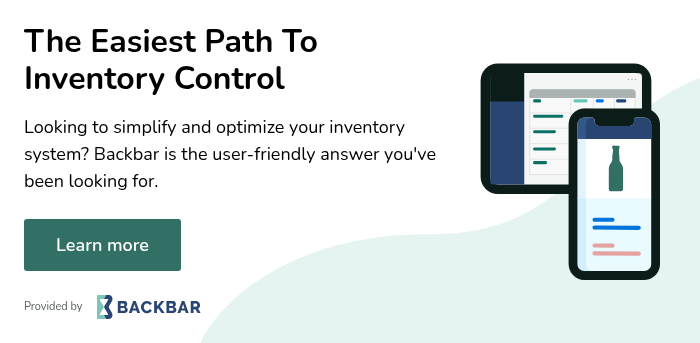Wine is one of the most ordered drinks and high-end and smaller bars and restaurants nowadays. Once upon a time, wine had a stereotype of being for the "older crowd" or any for fancy occasions, but not anymore. Casual drinkers and budget drinkers alike are enjoying more and more wine as the category expands in both options and popularity.
Let's break down some of Backbar's predictions for wine trends for 2024.
1. Boxed Wine Breaking Boundaries
Long gone are the days of boxed wine having a bad stigma attached to it — bag-in-a-box wine solutions are also becoming increasingly popular. Box wine offers sustainability and still provides companies with the ability to design attractive packaging via the large outer box. At one UK grocery store, sales of boxed wine were up more than 40% post-pandemic.
There are a few factors to the rise in box wine popularity. One is simply that you get more for your money. Box wines tend to come in 3 to 5-liter options making them larger than a standard bottle of wine. Not to mention the box reduces consumers' and the company's environmental footprint since it's more sustainable to make and dispose of.
Lastly, the quality of box wine has gone way up. Box wine was already an intriguing choice because the wine will last longer once opened compared to a bottle of wine since oxidation, which is what causes wine to spoil, is almost eliminated with the bag and box method. But, the actual product inside has come a long way as brands lean into the trend and embrace the box wine lifestyle.
This trend also extends into canned wine which is also becoming more and more popular.
If you choose to offer a boxed wine option on your menu it'll be easy to store and last longer once opened than traditional bottles of wine. So it's something to think about.
2. Orange Wine Niche
Orange wine, which is also known as "skin-contact wine," isn't made with oranges. When making white wine only uses white grape juice and with red wine, the juice and the skin are used which gives the wine its color. Orange wines are created using white grapes with their skins on. This means that, while the crushed grapes are fermenting, they take on a more tannic quality from their skins and pips and a deeper color. Most skin-contact wines are more of a golden yellow than an actual orange, but some result in bright amber wine.
Generally, orange wines are described as being robust and full-bodied with a great depth of flavor like a red wine but with the refreshing qualities and after notes like a white wine. Some orange wines can be kind of intense in flavor and therefore can only be enjoyed in very small quantities.
The global orange wine market was valued at $40.1 million in 2022 and is set to grow to around $67 million by 2032.
Common tasting notes include:
- Bruised fruit
- Jackfruit
- Savory flavors like hazelnut
- Fruit beer
- Apricot
Food pairings with orange wine should be bold flavors to match the bolder-tasting wine. Asian dishes are a great choice.
3. Non-Alcoholic Wine Craze
Just like non-alcoholic beer and cocktails, non-alcoholic wine is a hit. Market research survey shows the global demand for non-alcoholic wines is expected to increase at a CAGR of 10%, between 2023 and 2024. Wine has as many as 1,300 variations so the possibilities are basically endless.
Most non-alcoholic wine drinkers can be put into two categories. One, they simply don't consume alcohol but still want to enjoy the experience and/or taste of wine. Two, they're convinced by the lower caloric count in alcohol-free wine. A typical regular wine holds about 24 calories whereas a non-alcoholic option typically has about 1.7.
Whatever the reason it's important to have at least one or two non-alcoholic wine choices on your wine menu to attract more customers.
4. Restaurant Wine To-Go
The takeout and to-go rates skyrocketed since COVID. While consumers and getting back into the grove of eating and drinking outside their homes, the idea of having a restaurant experience at home is still a popular and appealing option.
30- 40% of restaurant revenue came from wine sales during the pandemic, it became a crucial revenue stream. Canned wine in particular, rather than a clunky glass wine bottle, became an easy option for restaurants to adopt alongside takeout menus. They're typically cheaper to order for the restaurant and easier to travel with for the consumer.
During COVID a lot of states altered or changed a portion of their liquor rules to accommodate for selling wine, beers, and cocktails to-go and most have decided to still allow it. But it's important to fully know your local laws before indulging in this profitable trend.
5. Rosé All-Day
Rosé may have really hit the scene in 2017 and then saw a jump in 2021-2022, but it looks like its popularity isn't slowing down anytime soon. Millenials in particular enjoy the slightly sweet and refreshing taste of rosé paired with it's Instagram-worthy look. According to IWSR, the market analysis of rosé is forecasted to grow by almost 70% from 2020-2024.
Traditionally, rosé is made from a blend of red and white grapes, focusing on creating a light and refreshing flavor profile. However, nowadays winemakers are really exploring the potential of rosé by blending lesser-known grape varieties or even creating rosé from a single grape variety.
Such experimentation has resulted in fun, unique, and exciting rosé options. For example, a combination of Grenache and Syrah wines can create a rosé with a deeper pink coloring and bolder fruit flavor. Or, a rosé made from the Mourvèdre grapes can have an interesting, savory, and spicy taste profile.




